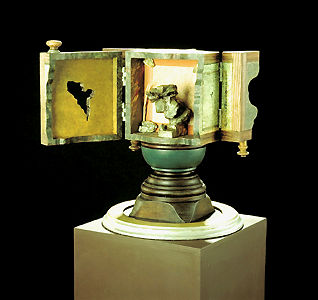Sorel Etrog, CM, artist, writer, philosopher (born 29 August 1933 in Laşi, Romania; died 26 February 2014 in Toronto, Ontario). For more than half a century, Sorel Etrog was one of Canada’s most renowned contemporary sculptors. A Member of the Order of Canada and a Chevalier dans L’Ordre des Arts et des Lettres in France, Etrog’s work is included in museum collections around the world, including the Art Gallery of Ontario, the National Gallery of Canada, the Museum of Modern Art, New York, the Solomon R. Guggenheim Museum, New York, the Hirschorn Museum, Washington, DC, and the Tate Gallery, London. In 1968, Etrog was asked to design the Canadian film award called the Genie. A career-spanning retrospective of Etrog’s work was mounted at the Art Gallery of Ontario in 2013.
Early Life, Education, and Career
Born in Moldavia in what is now northwestern Romania, Etrog, who was Jewish, managed to survive the Second World War and immigrated along with his family to Israel in 1950. In Israel, he studied drawing, painting, sculpture, graphic design, and theater set design at the Tel Aviv Art Institute. His first exhibit in 1958 in Tel Aviv helped win him a scholarship to study at the Brooklyn Museum in New York. In 1959, the Solomon R. Guggenheim Museum purchased one of his early sculptures. It was during this period in New York that Etrog met his long-standing collector and patron, Samuel Zacks, leading to his first solo exhibition in Canada at Gallery Moos in Toronto. Etrog moved to Toronto is 1963 and became a Canadian citizen. He was one of the three artists who represented Canada at the 1966 Venice Biennale, alongside Alex Colville and Yves Gaucher.
Mature Style
Etrog’s style is deeply indebted to both surrealism and Pablo Picasso’s work of the 1930s, as well as to major 20th century sculptors such as Romanian-born modernist Constantin Brancusi and American abstract-expressionist David Smith. While much of Etrog’s work appears abstract, it invariably alludes to the figure and more specifically to the human form. Etrog’s overriding theme is the integrity of the human body in an industrialized world, and thus his sculptures typically consist of elaborately interlocking parts that resemble the elements of a machine. In Ariana (Big Queen) (1961–1963), for instance, a widening shaft rises from a pedestal and bursts into curving forms that resemble shoulders and a head. In another work in bronze, Don Giovanni (1967), knotted shapes rise into rough, rectangular wing-like shapes, eventually curving up to a triangle that stands in for a head.
While Etrog’s finest work is sculptural and in bronze — he worked directly with plaster models, which allowed him to give even large sculptures an intimate sense of detail and texture — he was also an accomplished painter and draftsman. Etrog typically used painting and drawing as a testing ground for ideas he then developed into larger sculptures. In Vladimir and Estragon (Waiting for Godot) (1967) — the title refers to the two main characters in Samuel Beckett’s play Waiting for Godot —giant hands interlock with faceless heads inlaid with rings and bolts. Two Haitian Women (Homage to Gaugin) (1968/69), a painting in oil on Masonite in tribute to the great 19th century French painter Paul Gaugin, consists of schematic figures facing each other built up out of interlocking wrenches, the colours cool blue-greys and smouldering reds.
Public Commissions
Etrog received numerous major public commissions, including Expo 67, Montréal; SunLife Centre, Toronto; Windsor Sculpture Garden, Windsor, Ontario; Los Angeles County Museum; and Olympic Park in Seoul Korea. For the Pavilion of Canada at Expo 67, he created Flight (1967), which features a pair of wings sprouting from a dense knot of forms and twin heads hovering above. Dreamchamber (1976), located on Bloor Street in downtown Toronto, consists of large interlocking wedges of bronze that resemble a brain split open for view. Sun Life (1984), set in front of the Sun Life Financial Centre in downtown Toronto, is, on the other hand, more purely abstract, with rectangular bars jutting sharply from a circular base like rays of sunlight.
Other Activities
In addition to his work as a painter and sculptor, Etrog published poetry, plays, and non-fiction, including the books Dream Chamber: Joyce and the Dada Circus – a collage (1982) and The Kite (1984). He did book illustrations for Eugene Ionesco and Samuel Beckett. He also collaborated with Marshall McLuhan on the publication of Spiral in 1976, a book interweaving still images from his 1975 film of the same name with quotes from a wide variety of writers.

 Share on Facebook
Share on Facebook Share on X
Share on X Share by Email
Share by Email Share on Google Classroom
Share on Google Classroom



